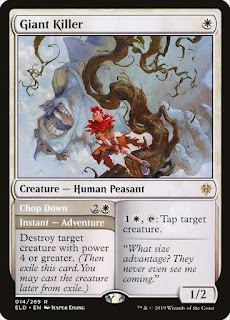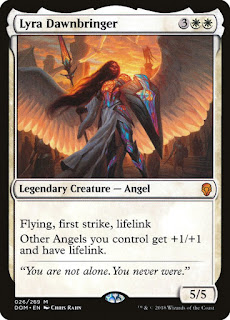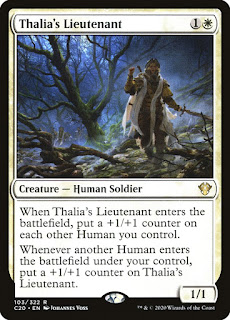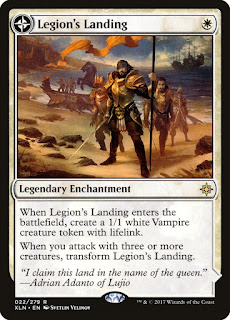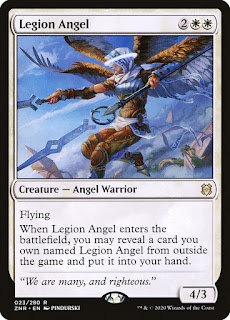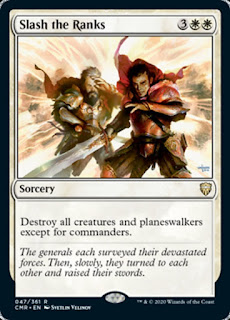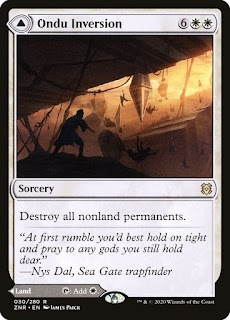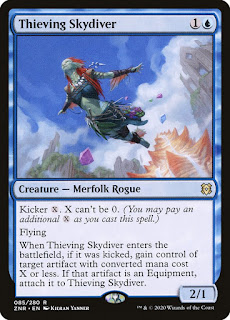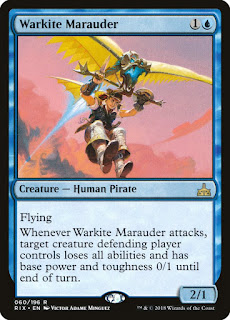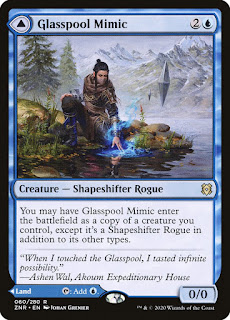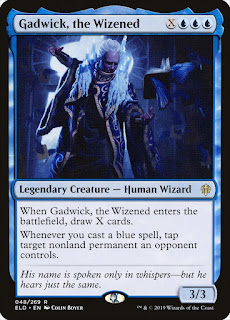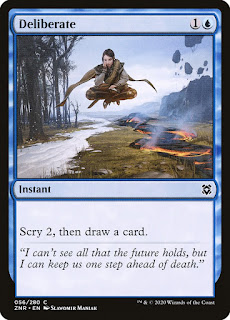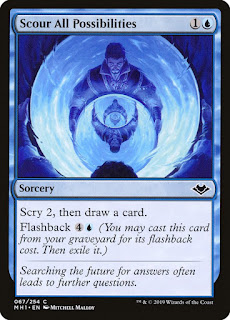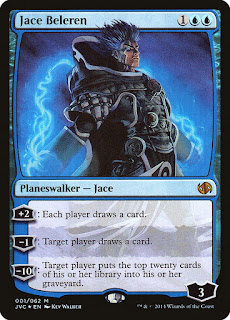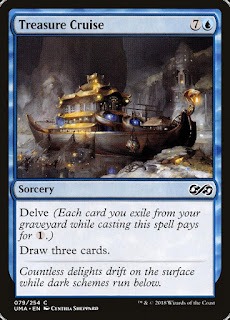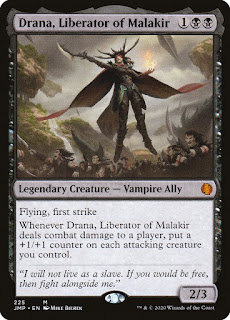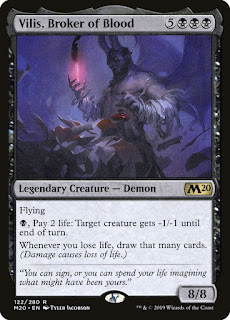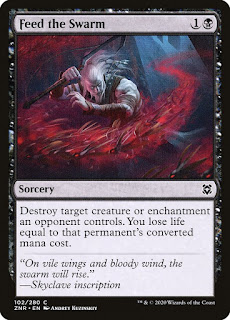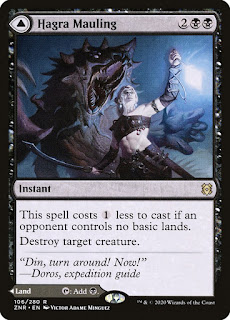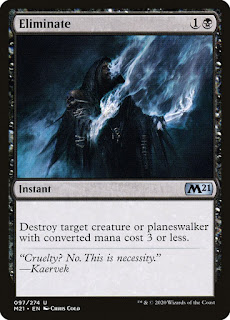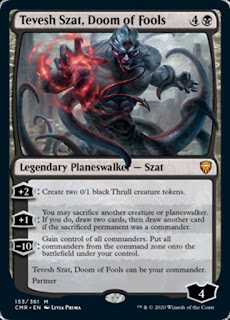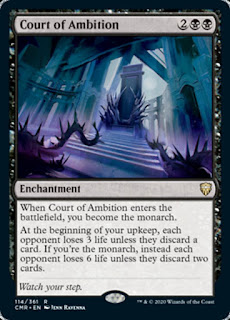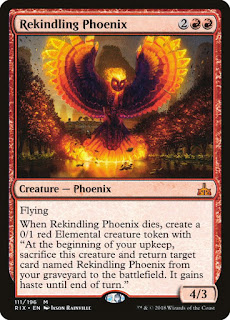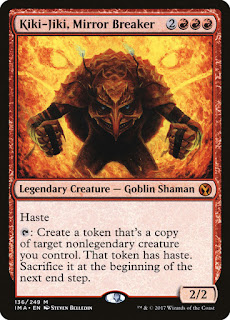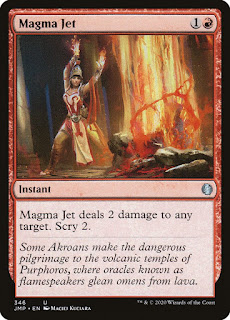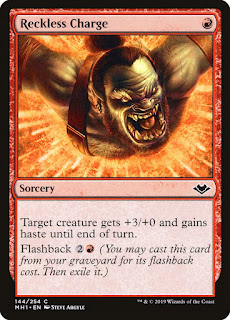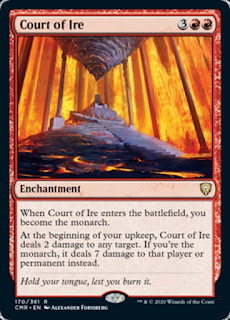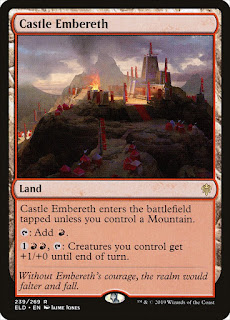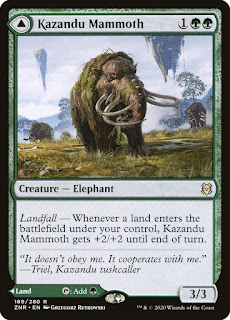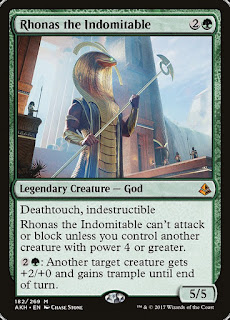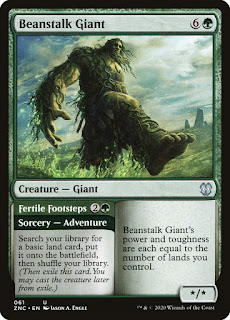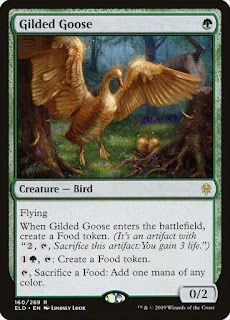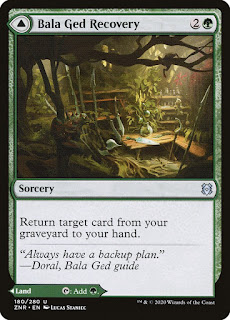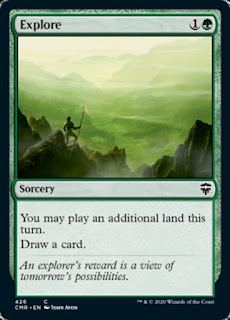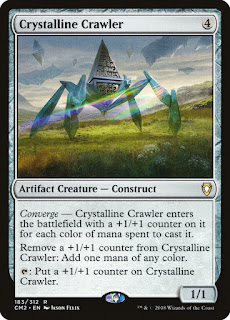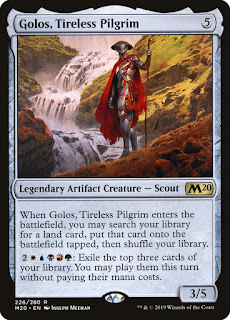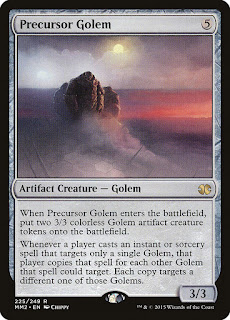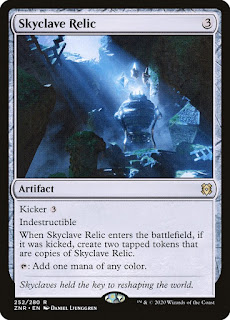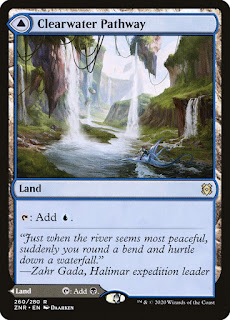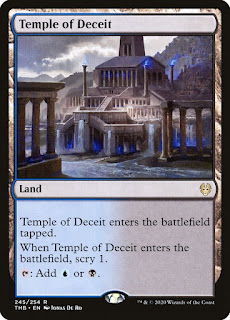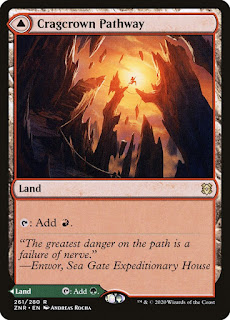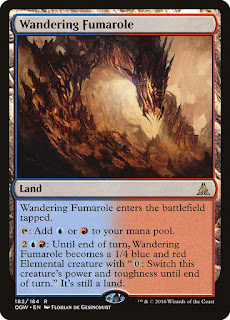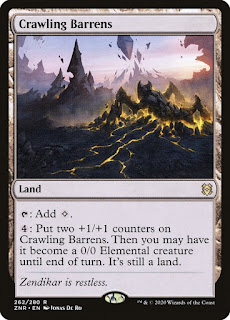Introduction
Welcome to a rather large update of The Awesome Cube! We are covering both Zendikar Rising and Commander Legends in this update and there are a lot of cards to go through. Before we get to talking about individual cards I need to discuss MDFC's for a minute. These cards remind me a lot of the Adventure mechanic from Throne of Eldraine in power level even if they more closely resemble split cards in form and function. While it's true that you only get one side of the card and that both sides are below rate on average, the flexibility between being able to have a land or a spell at any point in the game is incredibly powerful. This has become readily apparent throughout normal play with these cards and I think this will translate to cube as well. It smooths draws and helps to mitigate both mulligans and mana flood/screw depending on when they are drawn. Having one or two in your deck can go a long way towards just ensuring that more interactive games of magic get played and everyone has more fun. I'm going to discuss a lot of them here and I don't want to have to repeat this every time so just keep in mind that all these cards share this inherent advantage. On a side note, this is the first update since Google Blogger changed up its formatting and I'm still getting used to it. Hopefully I'll get more comfortable through continued use. Let's get going!
White
Giant Killer is the first beneficiary of the Adventure mechanic overperforming it's already high expectations. It was borderline when I initially reviewed it and it's reviews have been highly positive elsewhere. A fully functional card in its own right, having access to Chop Down is just added utility and is one of those effects that is going to be extremely relevant when it has a target. If it doesn't, there's an acceptable alternative in an over-costed tapper. Getting both is good value and this should fit into a number of different white builds adequately.
Lyra Dawnbringer is unquestionably powerful but has resulted in poor gameplay and while it feels weird to say, just isn't needed anymore. Lyra completely stonewalls aggro decks if she isn't removed immediately because of her combination of abilities it isn't really feasible to attack around or over her. However, she doesn't give any immediate bonuses and if she is removed you get nothing for your investment. Either way, one person feels unsatisfied with her game play. Add in that she doesn't synergize well with anything and you have a card that is just fine in pure power level but lacks somewhat in actual gameplay, fun and interest.
Luminarch Aspirant fits very well into a number of different white archetypes. It comes down early and can attack as a 3/3 as early as turn three. It can support go wide synergies or +1/+1 counter synergies while also providing immediate bonuses to push damage and make your early game creatures more respectable as the game progresses. Given the opportunity this can get completely out of hand and even in the fact of immediate removal, you are getting your initial counter no matter what.
The meager bonuses experienced by Thalia's Lieutenant were never expected to be very impactful. It was pretty much just taking up space until something interesting to test came along. It just doesn't provide enough triggers without a dedicated human deck and while you are likely to be able to trigger this in nearly all of your decks, you just can't do it consistently enough and on curve. At most you put on or two counters on your creatures and then can't grow this afterwards or you get a slow growing 3/3. Neither of which is all that exciting.
Skyclave Apparition is an interesting take on Fiend Hunter and I think these changes are for the better in cube. The 2/2 body is more aggro friendly than the largely defensive 1/3 which fits better into the decks that want to play this. Expanding the range of valid targets beyond creatures is a huge boon and more than makes up for the CMC restriction as the most common play patterns is just removing blockers out of the way to push damage. CMC 4 or less hits most planeswalkers, enchantments and artifacts that are in the cube and while it can't do everything, this is more than enough. Giving your opponent a vanilla X/X is significantly better than the original card coming back, especially considering all of the ETB effects in cube. While this was a slightly overstated concern with Fiend Hunter, this updated effect is much more palatable.
Monarch is a stupidly powerful ability. It has a lot of snowball potential that can lead to some degenerate gameplay but it also creates a really fun and interesting board state the rest of the time. Archon of Coronation leverages Monarch beautifully for control decks as it draws you a card the turn you play it even if it eats a removal spell and provides a solid blocker to help keep Monarch on your side if it doesn't. It's quite strong when trying to stabilize as even if your opponent is able to take Monarch away from you, its likely going to be through at least one favorable block and you won't be losing any life, keeping you alive an extra turn, something the control decks should be able to take full advantage of.
Sun Titan has been a pet card of mine for a long time. I have a lot of nostalgia for it and for a long time it promised interesting interactions and a lot of consistent power. In reality though, it just isn't a game ending card. It's a grindy value engine that control decks don't really want and aggro decks can't afford. It's good. It's just not going to excite any decks except Orzhov and they really don't have trouble closing out a game. It has a bunch of cute and fun interactions but it's lagged behind more recent control finishers for a while now.
I mentioned the snowball potential of Monarch with the last card and Court of Grace straddles that line a little tighter. Getting Monarch on ETB provides immediate replacement (something I'll stop repeating now) and if you are able to retain it you should be able to put away the game in short order. Even if you can't it provides repeatable evasive tokens that should be able to take Monarch back or start gumming up the ground on defense. The one thing that keeps this cycle from completely snowballing is that they don't commit to the board the turn they are cast which gives your opponent one turn to figure out a way to become the Monarch. A savvy player will be able to leverage the game state to hopefully prevent that but it's nice that this just doesn't do everything immediately. There's still a chance that this is untenable but I want to give it an initial run and see how it performs. I'm expecting big things.
Sevinne's Reclamation is cute and can do some really fun things but it's also very slow. This acts a lot like
Unburial Rites in practice and is just as slow and grindy. The problem is that you don't always have an exciting target for this and as a reanimation spell it's both slow and restrictive. This just doesn't make the cut in most decks over removal, efficient reanimation and other value cards.
I spoke in the introduction about how highly I'm valuing MDFCs and Emeria's Call is the first example we have. Having a land on the other side just makes this such a free roll to include in your deck unless you are extremely low to the ground.
Broodmate Dragon in one color is strong and tacking on an extra mana for indestructibility and the option to be a land on demand is incredible.
I really like the design of Legion's Landing but much like with
Windbrisk Heights, it's just not that easy to attack with three or more creatures every game. You can suicide attack in hopes of flipping this but it usually isn't worth it as the payoff is slow and won't make up for the loss in board state fast enough. Go wide token decks can usually trigger this without too much trouble but you are just getting so little for your initial investment, especially if you aren't casting this on turn one. A control deck would like the flip side but it's not going to be able to actually trigger the flip. It's just an awkward fit and slightly too underpowered on the front side.
Party as a mechanic just isn't ever going to work in cube due to the lack of requisite creature types available in each color. You might get two but getting to three is very unlikely and getting to four is actually impossible. Because of this, I won't be talking about many. Best case scenario for Archpriest of Iona is going to be a 2/2 if you are able to play a Warrior but you aren't getting more than that and I'm already not excited about playing a whole bunch of vanilla 2/2 for W in my section. I certainly don't want to play one that makes me work for it.
Prava of the Steel Legion provides a significant boost to tokens but limiting it to your turn restricts this to aggro decks. While you can attack safely with anything because of the toughness boost you aren't really attacking through things as much as ensuring you bounce off of them. While Prava has the ability to go wide, it's extremely expensive and since the bonuses are entirely dependent on Prava surviving, it's unlikely to live long enough to reap all of these rewards.
I love the design of Legion Angel but this ability just doesn't translate well to the singleton nature of cube. You can make this playable (and quite good) by providing a couple extra copies of the card to whoever drafts it or ensuring multiple copies of it are seeded in every draft it's in but neither of those options are worth this overhead of maintaining and explaining that every draft. If you are really attracted to these types of effects, this is one of the better ones but it's just not worth the headache.
Angel of Destiny is a potentially very powerful creature that just creates terrible game play and warps everything around itself in a very not fun way. The joined lifelink is gimmicky and can backfire spectacularly if your opponent is able to kill this before you can win the game with it. Six toughness should protect this from burn but there are still a ton of ways to deal with it. At best, this ends the game a turn or two after it is casted. At worst it prolongs a game unnecessarily and puts your opponent out of kill range before dying and making the rest of your deck make up the difference. No amount of the first justifies the second.
Didn't Make the Cut
This version of Akroma is yet another over costed fatty but the lack of haste makes this much less appealing as a reanimation target. It's a strong creature once in play but without an accompanying board it's just another
Baneslayer. Decks aren't going to want to ramp into this and control decks don't want to play this as a finisher without other creatures. It's not a good reanimation target and is too expensive to play in normal decks. This just misses on all levels.
I wasn't even considering Akroma's Will until I saw the comparison to
Unbreakable Formation, a card I've been pleased with in my own cube. This costs one more mana but you gain some more flexibility and don't have to concede the instant speed to gain full effect. The issue I have is with the combination of abilities on each mode and the inclusion of the commander phrasing which just distracts and confuses. The first ability has the ability to end a game with any sort of relevant creatures in play. The second is a much more defensive, reactive combination of abilities that can keep you and your creatures alive in response to a wrath, targeted removal, or merely to allow for favorable blocks. This should keep it relevant at all phases of the game both offensively and defensively. Ultimately though, four mana is a lot for something that doesn't boost power or toughness and is completely reliant on your board state. That, combined with the annoying commander phrasing makes me want to avoid this.
Didn't Make the Cut
Felidar Retreat can provide continued board presence and the ability to go over the top of your opponent's creatures but fails to guarantee that value turn after turn. This is more like a planeswalker than an enchantment and not being able to activate it every turn really limits its power level in cube. You really only have four or so activations of this over the course of a game because of how expensive it is up front and it's without a reliance on fetch lands you are likely limited to one activation per turn as well. If you aren't hitting land drops this does nothing and won't even give you value the turn you play it unless you wait until turn five and are able to follow it up with a land, something that just isn't a given even in the more land heavy midrange and control decks.
Slash the Ranks is another five mana wrath variant and as I've discussed in previous updates, I just don't have very many slots I can dedicate to this effect at that cost. Destroying all planeswalkers is a powerful, unique effect but is will be awkward in a control deck that likely is running its own as a way to take over a game. Normally, you can wrath away creatures and continue to hide behind your planeswalkers once you've stabilized to reestablish board presence or press your advantage. This doesn't do that and provides much more symmetry. I can see this being a great sideboard in the control matchup depending on the makeup of your deck but given the choice you are going to pick playing planeswalkers over this every time.
Didn't Make the Cut
The difference between Emeria's Call and Ondu Inversion is the relative playability of their front side.
Planar Cleansing at six mana is already not an exciting effect for cube and adding two mana puts it just outside the realm of even being able to be casted. Eight mana is just too much unless you are playing a ramp deck and this isn't a card any ramp deck would want. An MDFC wrath effect would be very good but at this cost it's just always going to be a land or the game will end before you get there as it rots in your hand.
Blue
In Out
I really like Thieving Skydiver as a role player in the tempo deck and a main deck answer to artifacts. More cards like this make me feel even better about not having to provide slots to
Naturalize type cards. This is particularly true in blue where this unique effect is much better than the reliance on bounce/counter to answer a troublesome artifact. This is even better in powered cube where it can steal
Moxen and the like but in my unpowered cube it's still going to work perfectly well as most of the artifacts cost three or less mana. Since the Kicker is a straight X you are paying for the evasive body and the artifact separately but never more than they would be individually. This makes it good at any point in the curve even if the body doesn't scale with your mana.
Warkite Marauder was a plant for the tempo deck and Thieving Skydiver provides more utility and late game power. Warkite was just taking up space as removing a single blocker on attacks was never really that impressive and it got played due to necessity of threat density only.
Clone effects have been very difficult to get working in Cube because the fail scenario is so significant. Only being able to clone your own creature does not help this risk but being an MDFC does so some damage control. This is a good rate at three mana but in some ways this is more of a commentary on how I feel about MDFCs than how I feel about this card. Getting some number of MDFCs in your list is just going to help your limited environment and make more games playable.
Gadwick turned out to be a bit more mana intensive and his tap ability was a little less relevant than I'd originally anticipated. Tempo decks really don't want to be spending upwards of four to five mana for this which it's such an inconsequential body. Removing a single blocker is nice but you aren't really taking advantage of it when all of your creatures already have evasion and you are wanting to be the one pushing racing anyway. It might help Gadwick get through but it's not the boon I'd hoped. Casting this in the extreme late game is still good but playing this out on turn four or five didn't impact the game the way it needed to compared to what you could be doing with that mana elsewhere.
In Out
There are only so many slots that I can afford to these filtering effects and while most blue decks appreciate their presence, they don't really want to load up on them. Deliberate is just an instant speed version of Scour All Possibilities and while you are giving up the ability to Flashback the card, that was already so expensive and slow that it's really not going to count for that much. Being an instant just works too well with the rest of blue's reactive spells.
Yet another Monarch card doing something unique. Fall from Favor is a single targeted removal spell that provides card advantage at a very reasonable cost. The Freeze ability at three mana is normally a one time effect or it costs four mana to permanently tap something. Adding Monarch at no additional cost puts this squarely into solid playable territory. The fact that the creature can potentially untap if the Monarch is stolen away is mitigated by the fact that their creature won't untap until the following turn, allowing you an extra avenue to take it right back yourself. This is a strong removal spell that blue typically does not receive.
I had put Force Spike back in the cube a while back because of the story potential but it's just really not all that good. The times you can cast this are just so infrequent and even then you are shooting this off on the first available opportunity regardless of if you are countering something that matters. It just doesn't play that well and is a dead card way too often.
In Out
I've been removing Jace Beleren from cube every couple sets for what feels like a decade. As I've previously said, he's an efficient but very boring card. Jace, Mirror Mage supplies a much more interesting gameplay pattern and demands you make choices that impact your win rate. There's less autopilot and the ceiling is much higher. Being able to Kick Jace lets you play with the abilities to maintain a high loyalty count while drawing lands or to as many as four cards deep per turn. That's going to find you whatever you need in short order. It also has the option of just drawing two cards if that's what the situation calls for. You don't automatically lose your planeswalkers when this happens, it's just a possibility. There's enough variety and power here that I'm excited to see how he performs.
In Out
I've heard very good things about Hieroglyphic Illumination from other cubes and I liked my limited experiences with it previously already. I've been happy stapling Cycling onto functional cards from a gameplay perspective as it allows you to flex your spells at various points during a game. This isn't going to ever be the best card in your deck but most decks will want to run it.
Deep Analysis provides a lot of card advantage but it's historically been way too slow. Best utilized when discarded for benefit to leverage Flashback, it rarely gets casted twice and there are games where you just can't afford to take your whole turn off to draw two cards. Sorcery speed hurts quite a lot here and Hieroglyphic Illumination is going to be a more consistent role player, even if the ceiling isn't quite as high.
In Out
Much like with the last card, one mana cycling is very strong and colorless mana is even better. Adding cycling to
Opportunity is good even if it comes with a downgrade to sorcery speed. Four cards is just so many and colorless cycling is yet another ability that mitigates mulligans and ensures functional games when things don't go according to plan.
Treasure Cruise just isn't very good in cube. In constructed, you are routinely paying one to two mana for this because of fetch lands and an extreme density of cheap spells. In cube you just don't have that same luxury and this has played out as a hard to cast
Concentrate more often than not. By the time you can actually Delve away enough cards to make this cost that one or two mana it's so late in the game that this could have been any other card draw spell several turns earlier. Delve is good in cube, but the effect really has to be there and it can't demand such an exorbitant cost.
Didn't Make the Cut
Sea Gate Stormcaller is never going to get kicked and I don't care what anyone says. Having to pay 7 mana plus whatever else you are casting just isn't going to happen. Ramp decks don't have an abundance of meaningful spells for this to copy and control decks aren't getting that high in mana very often. That means the base case here is a
Snapcaster Mage that's locked at four mana and can't use it's abilities reactively. That's a significant drop off and removes the main reason why the effect is good in the first place. It's a cool design but for cube it badly needed Flash or a more reasonable Kicker cost.
I keep seeing a lot of interest surrounding Hullbreacher but I just don't see the appeal. Most cube decks have a way to draw extra cards, although the density of that effect will vary wildly depending on the matchup. This needs to counter a draw effect in order to actually be worthwhile as the 3/2 body isn't winning any awards, Flash or not. Control and midrange decks aren't going to want to play this and while even a tempo deck can find some use for treasure, the lack of evasion means this is still just a kind of roadblock. The easy comparison is to
Notion Thief and that card underperformed mostly due to cost and timing restrictions. This body and cost are much better but I'm not convinced that the Treasure is going to be worthwhile. The real draw is preventing their card advantage and that's just not an easy thing to line up all the time.
Didn't Make the Cut
My original reading of Sakashima's Protégé had me much more excited than my second reading. I had initially missed the clause that stated the permanent you want to copy had to enter play on the same turn as this. That's just not going to be a reliable enough option. I love that this has Cascade and the design is great but at six mana you absolutely need to be able to hit on the copy and that's just not a guarantee, even with the free roll of Cascade.
Unlike the other MDFCs I've discussed so far, Jwari Disruption lacks in a very important area. Both of its sides are at maximum value at the same stage in the game, the development stage.
Force Spike just got cut because it's only useful in the first couple turns of the game, before your opponent can build enough mana to pay the meager tax. Likewise, the land option is going to be most critical when you haven't built a mana base or during mulligans when you just need something to play your spells with. Late and mid game, both sides of Jwari Disruption are going to be difficult to utilize effectively as you no longer are in a need for lands and your opponent has excess mana lying around most turns. Force Spike already isn't exciting at one mana where you can hold it up without significantly affecting your ability to play your spells. Two mana is a lot more than one. Not to be additively distracted, the land option is still powerful, just not enough to get it into cube.
Didn't Make the Cut
Court of Cunning is easily the most disappointing Court and not because it isn't powerful enough. It's far too powerful and non-interactive. Milling ten cards kills in a turn or two (sure, they might not be dead but they aren't coming back from that) because of the forty card library in limited. There just isn't anything your opponent can do about it. They basically NEED to take the Monarch immediately or the game is over and that's just not good gameplay. It's possible the other Courts prove to be just as oppressive over time but right now this one is close enough to a known commodity (
Jace, Memory Adept) to easily exclude.
Inscription of Insight is your typical modal card that is a couple of below rate effects stapled together in the hopes that the total package exceeds the sum on its parts. The Kicker mode allows it to gain greater usefulness if you draw it into the late game. Unfortunately, the Kicker mode costs 5UUU which is a bit much to ask even if you are getting every mode. The token making ability is clearly the weakest and will rarely ever be selected. Even when you do everything you are looking at making a vanilla 3/3 on average and that's nearly worthless. Bounce or Draw are going to be the modes that get used and the optionality is nice considering they cover the wide array of potential board states but at sorcery speed, neither is that exciting. The difference between this being a sorcery and being an instant is a wide delta in blue and it's what gives me enough pause to keep this outside the cube list.
Didn't Make the Cut
Sea Gate Restoration is easily the most disappointing mythic MDFC (Deja Vu, am I right?). Despite holding the same advantages as the other cards in the cycle, the spell side is just abysmal. People continuously fall in love with cards like
Commence the Endgame because they only remember the times their hand is full and they benefit from all those cards they have. They ignore the fact that in the scenario where your hand is full, you are already winning the game. This needs to do something when you are behind or at parity in order to be anywhere near worth the seven mana required to cast it. This does neither and we just can't afford that .
Black
In Out
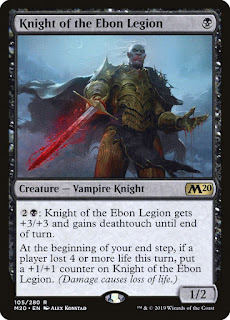
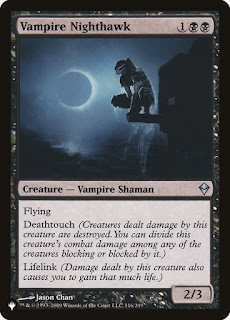
Finding functional one drops that aren't boring is one of my favorite parts about spoiler season. Knight of the Ebon Legion is a card that I had liked on release but shied away from due to it's aggressive lean. After mulling for a while, I think I actually quite like it regardless. Yes, it's an aggressive card but it scales very well into the late game due to gaining Deathtouch and it's threat of activation is a very real threat both offensively and defensively. It's a little expensive to activate but once you get to six mana and you can threaten to activate it twice you are looking at something that absolutely has to be blocked and can protect itself from burn. Yes, it can get more counters but the card is already good enough without that rider.
I've become so disenfranchised with Vampire Nighthawk that every update I look for a way to cut it but keep finding other cards instead. We're finally here and I'm not going to miss it at all. The calling card here is that with the combination of abilities it can play both offense and defense and own the battlefield but that just isn't the case anymore. It's still good against aggro because of the lifelink but only having two power doesn't let it race against anything even with lifelink. Defensively, it trades with so much that it's little more than an annoying speedbump. Add in that it doesn't have any inherent synergies or interesting gameplay and, like I said, I'm not going to miss it at all.
In Out
Nullpriest of Oblivion leverages Kicker to act as both an impressive early game attacker and a late game reanimation spell. Having no restrictions on the reanimation clause seems very strong for six mana when it's stapled to an evasive, lifelink body. The combination of menace and lifelink allows you to race early game if you are ahead or trade with something and recoup a little life if behind. Black should have no trouble having targets in its graveyard to reanimate by the time you get six mana even in decks that aren't focused on turbo reanimation.
Beacon of Unrest did an admirable job during it's time in my cube and stapling a creature onto it is quite a bit better.
Noxious Gearhulk is fine but that four toughness is a real drain on its ability to overtake a game. The best part about the card is gaining life but often you are killing a problematic utility creature and only gaining a couple. For six mana we need something that has a larger or more unique effect. Black has plenty of kill spells and while this was fine, it wasn't game breaking and often got left out for more impactful control finishers.
In Out

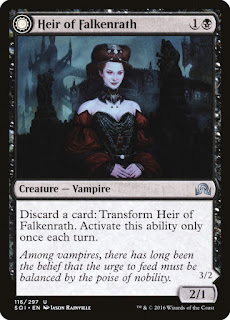
Skyclave Shade is the next iteration on the
Bloodghast formula and, while different, I think it compares favorably. Bloodghast was powerful because your reanimation was tied to a manaless ability in landfall, which made up for it's otherwise less than stellar physical abilities. Skyclave Shade ties up your mana but provides the utility of becoming something that can't really be ignored. This means that even if your opponent wants to block and kill it with a 4/4, being able to threaten returning it as a 5/3 should give pause. Note that you don't have to recur it with Kicker so you can use less mana to get another body in play. This should interact favorably depending on your deck speed and stated goal. Slower, more grindy reanimator decks can afford to put extra mana in to get a late game threat while low to the ground or sacrifice decks will appreciate the body at a cheaper mana cost just to pressure or use it as a disposable outlet.
Heir of Falkenrath is good as a discard outlet that doesn't require mana but the card is very bad if you don't have a good discard available. Cards like
Oona's Prowler succeed because they are functional cards outside of their discard abilities. Even the flip side, Heir to the Night, isn't really that exciting as you gain a 3/2 flier and lose your discard outlet. While that would be exciting if black skewed aggressively, it doesn't. This makes it an awkward fit as most decks that care about the reanimation do not care about the evasive body and vice versa.
In Out
Midnight Reaper does something that I'm trying to increase the density of in black and that's reward you for creatures dying without requiring mana or being tied to a sacrifice activated ability. This just rewards you when things die automatically. Losing a life is a real cost depending on how many creatures are dying but in practice you typically are able to build a significant advantage before that gets too scary. You can always sacrifice this if things get really dicey as well and since this triggers off itself you get to replace itself no matter what. There's a lot of power tied up in that considering it comes attached to a functional body.
Drana, Liberator of Malakir was a cool card for the black aggro decks but suffered from black's inability to both go wide effectively and build a strong aggro deck. Black is best suited as a complementary color in an aggressive Rakdos or Orzhov build but struggles when it tries to be base black. Those decks typically leverage the heavy removal and interaction black provides rather than its aggressive creatures. Drana needs to come down on curve and/or with an established board presence in order to maximize her value since she doesn't really have the largest body. She can add a ton of value if she goes unblocked and her abilities interact very well with each other but she doesn't fit into the decks black most wants to play making her an awkward inclusion and kind of a false signal to drafters about what black excels at.
In Out
I like having access to a couple of viable reanimation targets and Vilis is just a much better option than Sheoldred. He is more resource hungry than Sheoldred is but he's harder to kill without suffering some consequences. Even if you hold up a single black mana you are guaranteeing, at worst, giving something -1/-1 and drawing two cards. Sheoldred only begets value if your opponent untaps. All too often, they have an answer before you get that far. There's also an awkward synergy where if you reanimate her early in the game you might not have an established graveyard and therefore she acts as a very awkward fatty with a lot of meaningless text. The dream of growing your board while your opponent's dwindles has happened before, but not nearly enough to justify her anymore.
In Out
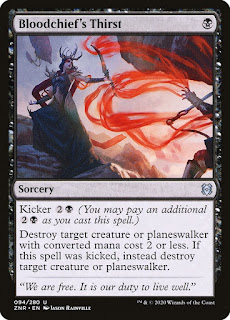
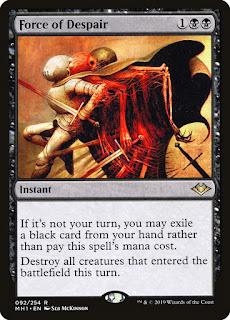
I really tried to make
Fatal Push work in cube but Revolt was just too difficult to get functional on demand, making it a very awkward draw if you weren't using the base mode. Bloodchief's Thirst is a downgrade to Sorcery, which hurts, but Kicker is a massive upgrade in reliability and the CMC restriction being removed altogether AND being able to target planeswalkers is a significant upgrade in terms of power and flexibility. That is to say that this still wouldn't be good enough unless the base mode is powerful and, thankfully, there are a ton of board situations where a one mana removal spell for an early game dork is exactly what you need the most.
Force of Despair is yet another card that suffered greatly for being entirely too situational for its own good. Only being able to handle creatures that came into turn when you cast it meant that all too often you would draw it, stare down your opponent's troublesome creature, and have to pass the turn and watch it attack into you. Being able to cast this for free is very powerful but it doesn't matter if you can't use it in a meaningful way. In this case, unique and unexpected does not make up for its limitations.
In Out
Epic Downfall did just fine during it's short time but I don't want to just keep increasing the removal density in black by removing other spells. Epic Downfall is a sorcery with targeting restrictions and that is enough to make it bottom of the barrel, even with the upside of forced exile. Opening up the restrictions and ADDING the ability to remove enchantments, a unique effect for black, is significant and well worth the cost of losing life.
In Out
Much like with Glasspool Mimic, above, Hagra Mauling is a slightly below rate effect stapled to an MDFC that is greater than its individual parts. The basic land restriction is almost never going to be relevant but even at four mana a kill spell is a kill spell and this is one of the more unique ones we have access to. I've waxed poetical about MDFC's enough so take what I've said above and apply it to yet another powerful, flexible option.
Eliminate misses out on a lot of meaningful targets by being restricted to three mana and the inclusion of planeswalkers is nice but doesn't really make up the difference. Hagra Mauling is more expensive but wins out due to the MDFC advantages.
In Out
I was pretty happy with Rite of Belzenlok during it's time in cube and it really did exactly what I expected out of it. It made multiple creatures that black decks were able to use for profit and I guess made some big dumb idiot that technically could have finished a game but wasn't really why the card was good. Tevesh Szat, Doom of Fools makes two tokens with a +2. That's repeatable. It puts his loyalty up so high that it's very difficult to kill in combat, especially considering that it is creating multiple blockers each turn. Being able to have
Skullclamp on a stick is incredible, and it's a +1 to boot. All this loyalty pumping is offset by not actually having a functional ultimate unless you are playing Commander (we aren't). This is all the best parts of Rite of Belzenlok while being easier to cast (one pip, not two) and beign imminently repeatable. This is a very strong card and one that I'm surprised isn't getting more love.
In Out
Agadeem's Awakening realistically starts off as a six mana card and then scales incredibly well into the later game. Being a land, again, makes up for it's early game foibles and this provides a lot of power as a finisher in any non-Rakdos black based deck. Black wants to grind it out and this is yet another card that makes good use of any creatures that were sacrificed or acted as roadblocks for the cause. This interacts particularly well in Golgari where your self mill and ramp pull double duty to make this a real game ender.
Malefic Scythe didn't translate to cube very well. You can get counters on your creatures but it doesn't create a brick wall in the same way that it does in retail limited. There's just too much going on and black doesn't have a lot of ways to leverage the larger creatures. It's just too grindy. Your opponent is more able to ignore your physically larger creature by going around or over it and the lack of other utility counteracts the inexpensive equip cost.
Didn't Make the Cut
Scourge of the Skyclaves is a play on
Death's Shadow as a variant body that's dependent on life totals. That's not an easy thing to control and while this does provide a bit of management in that area, it comes at the cost of 7 mana, something that's not going to work when it's getting you a vanilla body. Early game this is actually uncastable unless both players have lost life, something that isn't very likely on turn two. It's just too hard to control and is bad at the stages of the game it needs to be good.
Opposition Agent is a lot like Hullbreacher, above. It's a flash body (same body/cost, actually) with an ability that hoses something specific your opponent does. In this case, that's search their library. A lot of people are really excited about Opposition Agent because of the disgusting upside and story potential. In practice, this exists solely to screw your opponent out of their mana. Yes, library search does exist outside of fetch lands and ramp but the density is nowhere near as high in my cube because I'm not pushing combos that require a certain density of tutors. Screwing your opponent out of their mana goes against my cube philosophy and I'm not adding a card whose only existence is to do just that, even if it does have great story potential.
Didn't Make the Cut
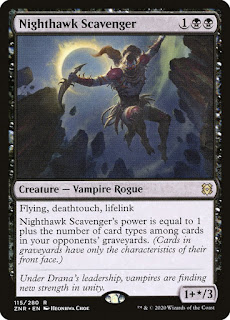
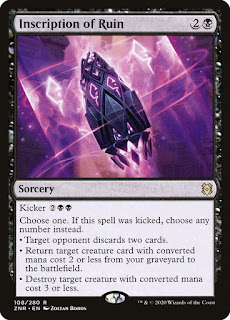
Wizards would do this to me. The second I find a way to get rid of Vampire Nighthawk guilt free, they come along and print a new and improved version. And it is quite a bit better. For the same mana cost and with the same suite of abilities we are getting a variant power that will be anywhere from 1 to 5 or 6 depending on the board state. That said, we've seen this ability before on
Tarmogoyf and it wasn't that great even when it counted every graveyard. This just counts your opponents. While it's likely that they will find a way to get a creature and an instant/sorcery, the rest of the card types just aren't guarantees without some sort of mill component, something my cube just doesn't have. This carries no significant upgrades over Vampire Nighthawk other than that and it's not enough to change my assessment.
The abilities on Inscription of Ruin just don't scale well with the kicker cost. By the time you get seven mana it's going to be deep into the late game. At that time your opponent will likely not have multiple cards in their hand, reanimating a creature of such low CMC isn't going to be very high impact, and it's likely the small creatures aren't what you want/need to be destroying. In the early game this still isn't that exciting as none of these abilities are all that exciting at sorcery speed. This isn't awful just because of the modality but is far too restrictive in what it allows you to do.
Didn't Make the Cut
Court of Ambition suffers, like so many other cards, from giving your opponent the luxury of choice in how they deal with it's abilities. Having to discard a card or lose 3 life is annoying but manageable considering that they are drawing an extra card every turn by being the Monarch. The card is essentially paying for its own tax if need be. If you are the Monarch it's nearly impossible to keep up with as nobody is going to have two cards to discard for more than a single turn and six life ends the game in no time flat. I don't like the extreme delta between the two sides, especially considering that black decks typically don't pressure the opponent's life total in a way that leverages this successfully. Not impacting the board at all makes it easier for your opponent to steal the Monarch and render this unexciting. It's still good but not something I want to go out of my way to test.
Red
In Out
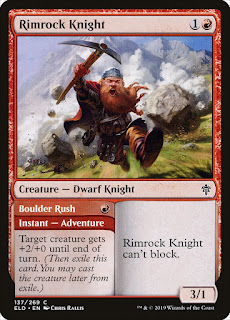

I'm always looking for ways to squeeze in combat tricks that are playable and I've been pretty surprised with Rimrock Knight as a two drop that gets a little extra out of an early game attacker. The lack of toughness boost means you are focusing more on increasing damage dealt to the opponent as opposed to actually winning a combat but it's unexpected and mostly free value when attacked to something that isn't that far off from being playable.
Robber of the Rich never was able to actually go off, mostly because it's a glorified
Grizzly Bear with haste. The ability has so many riders that it feels more like happenstance that you are able to trigger it rather than smart deck building or game play. The reach is completely irrelevant when it spends every turn sideways and it's just a lot of reading for very little gain.
In Out


Magmatic Channeler is just a significant upgrade on Burning Prophet. For the same cost and body you are being more self contained as opposed to being reliant on other cards. Burning Prophet doesn't really attack that well even if it's activating and Magmatic Channeler is pretty likely to be a 4/4 by the mid-game. The big advantage though is that while Burning Prophet sets up your future turns, Magmatic Channeler sets up your current turn. Being able to pitch lands in the late game or draw into lands in the early game keeps this relevant throughout most turns. It also fuels itself if you are discarding gas to dig for something. Just a really solid two drop.
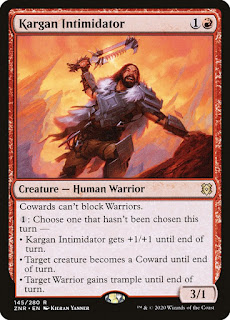

Kargan Intimidator is a nicely costed aggressive creature that has some utility that allow it to remain somewhat relevant as the game progresses. While you are going to get the most mileage out of it if you have other Warriors in your deck, the vast majority of the time you are looking at three abilities that will only benefit itself and maybe one other creature. The abilities stack very well if you have the excess mana but otherwise serve as a nice way to round out remaining mana left over from spells. This can attack for four on turn three and remove a blocker or just get in there and threaten to trample over if chump blocked. This should fit well in both the aggressive and midrange red decks and is a more consistent and versatile threat than Stormblood Berserker. Hands where you can't curve into Stormblood Berserker on turn two do exist and if your opponent has answers for your early game plays you do sometimes have this rot in your hand or have to run it out as a 1/1 which feels awful.
In Out
Torbran is messed up and you really don't need to be completely mono-red to feel the heat. Two extra damage is a LOT even if it wasn't attached to what is effectively a 4/4 for 4. This makes burn spells more lethal and makes blocking your small creatures much more difficult to do profitably. Even your tokens are going to be boosted and if this isn't answered it threatens to end a game quickly with even a little bit of support.
Rekindling Phoenix is more annoying than it is good. It's more persistent than it is fast. It does threaten a game but provides more eventuality than it does present a clock. If your opponent is able to remove the 0/1 then you don't get your bird back and while that doesn't always happen, it is a scenario that comes up. There's value in drawing resources from your opponent for this but it at the end of the day your best case is just an evasive body that's hard to kill. It fits well into the Gruul style decks and is okay in Rakdos but is pretty bad in both Boros and Izzet. Torbran is a very different card but one that provides a much higher ceiling and faster clock.
In Out
Wildfire Devils is a really fun card. For the same cost and body as Flametongue Kavu, you are getting a much more interesting and synergystic ability. Players are almost always going to have some targets for this in cube and against some decks it's just going to be insane. Even if you get one or two removal spells it's more than gotten its cost back. Triggering on ETB is critical here as there isn't a way for your opponent to play around it and you can craft a game state to really take advantage of the surprise trigger. FTK is still powerful but Wildfire Devils is way more fun and has a much higher ceiling with a comparable floor.
In Out
Emissary of Grudges essentially gives you and your permanents uber hexproof but only once. Your opponent has the choice of if or when they trigger it but it's nearly impossible to get out of that exchange unscathed. At worst it just counters the spell (no available targets for the redirect) but that's still very good even if it is telegraphed. Because this is so large and has haste you are asking your opponent to respond to something very quickly....twice. I also love the novelty of secretly choosing an opponent in a one on one match and then dramatically announcing who you secretly chose.
If you aren't playing Kiki-Jiki, Mirror Breaker in a combo deck then it loses a lot of it's luster. The body is nonexistent without the copy and while it can do some really fun things it also doesn't naturally fit into any decks. I'm not even running the other parts of the combo so I'd rather just take it out and not send drafters a false signal.
Roil Eruption is the best
Volcanic Hammer variant ever printed and reminds me very favorably of
Burst Lightning as an early game burn spell that provides some extra damage in the late game. Seven mana is a lot and most of the time you aren't going to get to that point in burn decks but in those situations they are going to be more than happy with the efficient burn spell, even at sorcery speed. Slower red decks (Izzet/Gruul) are going to be able to take advantage of Kicker as a game ending spell or just something to kill a larger target.
I really like stapling beneficial effects to burn spells but there are just so many times when you would really like that extra damage. Burn spells are good because of their cost to damage ratio and this just isn't a very good ratio. Scry 2 is great but it isn't card advantage, it's card selection and there are times where it just doesn't make a difference when you top both or aren't looking for anything in particular. It's best in the late game when you can bin lands or in the early game if you have a hand that screams lands/no lands. Roil Eruption is just bigger impact.
In Out
Chandra, Acolyte of Flame is a very interesting card that does quite a bit for only three mana. Making multiple bodies will be beneficial for the token decks and sacrifice decks even if they don't stick around past the turn. Even if you don't use the first ability to build loyalty you are looking at two activations of the -2 which can do quite a lot in red based spell decks even if it's just reusing burn spells. CMC 3 or less is quite a lot of stuff. In fact, using your burn spells twice in an effort to clear the field allows your tokens to start dealing damage or lets you take a turn off just to build towards another -2 activation.
I'm going to be honest here. I didn't even realize Reckless Charge was still in my cube. I assumed I'd cut it years ago. It's not bad but it just can't stand up to the power level of other cards in cube.
In Out
It's possible these Court cards are too good. Gaining Monarch is an incredible advantage but I'm betting that not being able to commit extra resources to the board to protect it is going to even these out a bit. The upside of Court of Ire is insane and you get a free 7 damage to whatever you want. That kills in three turns or it can eliminate pretty much any troublesome creature or planeswalker. The neutered version is a still relevant 2 damage that can do the same thing and will always have a target. I need to play with these to see what the average case is. They might be coming back out if the average play scenario is be completely fair and fun 30% of the time and instantly end the game 70% of the time. We'll see.
Forbidden Friendship is a plant for the token and sacrifice decks but just can't stand on it's own four feet when compared to higher powered cards. On it's own it just doesn't do that much beyond provide bodies and we have a lot of relevant cards that do that now.
In Out
Shatterskull Smashing scales reasonably well with your mana. It's functional at 4 mana and becomes much more powerful with each additional mana. At X=6 you are pretty much guaranteeing you are killing any two creatures/planeswalkers that you want but it doesn't get any better than that with additional mana because you can't ever target a player. That's fine because 8 mana is really about as high as you are going to ever get anyway.
Castle Embereth is fine as a utility land but it just provides such a small bonus and takes up a slot in the cube. It always gets played but rarely gets used for its ability. +1/+0 doesn't push through blockers and it doesn't allow you to survive trades. Four mana is essentially your entire turn and decks usually just have something better to do. I'd much rather play the card that smooths early game draws and provides much better late game value.
Didn't Make the Cut
Wayward Guide-Beast reminds me a lot of
Scythe Tiger as a very efficient one drop that demands far too high of a cost to actually use. It doesn't matter how low to the ground your deck is, you just can't afford to forego a land drop in the early game. Yes, you could replay your land and drop another one drop the following turn but that's a very steep decline from being able to cast a two drop, or two one drops, or a one drop and a burn spell. Even aggro decks need to get to three mana so they can start double spelling or playing their more impactful cards as soon as possible. You aren't going to overwhelm your opponent without doing so. Despite being pushed from a cost to body/ability perspective, it's not nearly strong enough to warrant such a significant drawback.
I really do not like
Steppe Lynx at all for cube. Akoum Hellhound is just a color shifted version and that doesn't change any of the things I don't like about the card. It does nothing when you don't draw lands and it loses a ton of value for every turn you cast it after the first turn. Everyone remembers Steppe Lynx so fondly because of its interaction with fetch lands. When your deck has at best one of them, it's not even worth considering as a part of the upside.
Didn't Make the Cut
Leyline Tyrant will absolutely end a game if it's not dealt with after a few turns. Pumping all but one of your mana into it for the sole purpose of killing your opponent is a valid strategy. You can also continue to play cards and funnel unspent mana into this every turn and just see what happens. Either way, this doesn't do anything until you untap with it and only works with exactly red mana. That limits this to mono-red decks if you actually want to take full advantage of it. It's not particularly interesting and warps your game plan around it while ignoring the rest of your deck. I don't love that play pattern and think this will prove to be rather un-fun to play with and against.
Aurora Phoenix is yet another card with Cascade that suffers from being way too expensive to put to good use in cube. Six mana in cube needs to threaten to end a game and you just aren't doing that with a large flying body, Cascade or not. It essentially doesn't have any other abilities as there aren't that many cards with Cascade in cube and I don't want to put all my eggs in the "hope I flip something good" basket.
Didn't Make the Cut


Spikefield Hazard is going to be able to find a target for that 1 damage. Whether it's a token or picking off a creature after combat damage is dealt, you won't have this rotting in your hand. However, it's just not really worth a cube slot. The MDFC is pulling way too much weight here for it to justify removing something else for such a small effect.
I spoke earlier about my love of choosing things secretly. Wheel of Misfortune technically does that, and it has the potential to be quite strong in a very aggressive deck as you will be able to bid more life than your opponent. Drawing seven cards in your aggro deck is worth a whole lot of damage to your own face but this seems really convoluted for what happens. I'd almost rather this just be a direct "take damage equal to your opponent's life total and draw seven cards". I'm not going to ask people to read and grok this every draft. It technically does have a lot of play to it and it heavily incentivizes the aggressive player but there's just so much text and only so much room for mental load.
Didn't Make the Cut
Valakut Awakening is going to hold a lot more value in cubes that promote combo or decks like
Sneak Attack that have pieces to them that are terrible in the hand without the other part of your combo. This can get those cards out of your hand and replace them with something functional, allowing you to tutor up the targets as needed. One of the risks of playing those types of decks is drawing pieces at the wrong time and sputtering while your opponent either aggros you out or locks you down and this does help mitigate that. For a cube like mine that puts a much lower emphasis on those types of effects and cards this loses a ton of luster. The effect becomes much better when stapled to a land but I still just don't like this effect very much.
Green
In Out
Kazandu Mammoth looks pretty unassuming but is going to make the cut in nearly every green deck just because of its raw efficiency and, again, being an MDFC. Attacking on turn four with a 5/5 is likely to be profitable even if it doesn't have evasion. Again, the power here is in the MDFC part of the card but I really want to get a couple of these into cube for testing and I think this one is just solidly good.
Rhonas is a trap. He demands a board presence beyond himself to function in any way and while that board presence does not technically have to include something that turns him on, it really should. Pumping costs far too much mana when you are doing it with the sole purpose of allowing him to attack. Oftentimes it is just better to use your mana elsewhere than be able to attack for extra damage, especially when your opponent has open mana. Pumping at sorcery speed and then getting your only creature with power 4 or greater killed is a great way to lose a game. This didn't work on defense, it didn't work on offense, and often acted as a win more card rather than something that can dig you out of any kind of hole.
In Out
I'm currently running both
Cultivate and
Kodama's Reach as three mana ramp because they both get multiple lands. Beanstalk Giant only gets one land (untapped) but it also provides a late game creature that doesn't ask you to use up a spot in your deck. It's not an amazing body but the biggest risk in running a ramp deck is that you will not get the right mix of ramp and fatties in your game. By acting as both, this just increases the consistency of your ramp deck. I like it in the same way that I like
Realm-Cloaked Giant for the control decks. This one seems better because of the unique style of card needed to accelerate your mana and how useless those cards are in the late game.
Gilded Goose ended up being way too mana inefficient and slow to stand up against the other mana accelerants. You really need to be able to use this for mana on consecutive turns and getting only one Food token means you can't do that. Creating more Food takes up your entire turn in the early game which defeats the purpose of ramping which is to get ahead of your opponent so you can play larger or more spells earlier. The late game utility of being able to create food for value didn't materialize either because, again, it's just too slow and expensive compared to the speed of the format.
In Out


I'm grown a bit disenfranchised with the fight spells in green. They just ask a lot of the player to obtain a return on investment. You need a creature in play, your opponent can't have a removal spell to blow you out and your creature has to match up well with the board. That last part is really frustrating because not only does your creature need to be large enough to survive the fight (or deal lethal for a punch effect) but it also has to be able to do that to whatever target MATTERS. All too often you meet all the criteria for your removal spell to function but your creature isn't big enough to kill the problem. You can use the spell to remove something else but not what is actively killing you. Ram Through doesn't do nearly enough to make up for these deficiencies despite being a punch instead of a fight, despite having some trample flavor text and (shockingly) despite being an instant. If all that is true, maybe fight cards just aren't good for cube. Now all of that said, Inscription of Abundance isn't a fight card. It's a fight card that can instead grow your creature or gains you life for the same cost. More likely you can wait until you have five mana and do all three. It's just a more complete spell that provides much more utility when you don't meet all the aforementioned conditions.
In Out
Regrowth is a good card because it's cheap, selected card advantage that allows you to immediately cast whatever card you return provided you have the mana (that's where the cheap comes into play). Bala Ged Recovery costs one more mana for the same effect but with the amount of times you are returning a cheap removal spell or expensive finisher you wouldn't have been able to cast immediately anyway, it shouldn't make too much of a difference. Where Regrowth effects really suffer though is in the early game. When your graveyard is empty you just can't cast those spells, they don't do anything without a valid target, and even then you want to be returning something that matters. Tacking this ability onto an MDFC is very strong as it makes up for the weakest part of the card; drawing it early in a game. Late game this will just always be relevant and in the early game you get to have an extra land to ensure this isn't really ever a dead draw.
Explore isn't card advantage or ramp, not really. It's just so rare that this gets played over actual ramp cards because you just can't guarantee that you have excess lands in your hand when you can cast this. When you are able to ramp and replace it's obviously better but even then you are paying a cost to do all that. Oftentimes it just isn't high enough impact and exists with way too much variance to be worth the slot.
In Out
If I've learned anything from
Collected Company, it's that you aren't very likely to whiff with Turntimber Symbiosis. You only get one creature instead of two, and it's a sorcery instead of an instant, but the counters do a nice job of making whatever you get more relevant in combat if you do end up with a smaller threat. Most of the time you will end up with something quite a bit larger and more expensive but it's nice that the only fail case here is if you flip zero creatures which, as mentioned, isn't very likely. Plus all the MDFC jargon same as before (that part matters a lot). It's worth noting that I think I'm maxed out on this type of effect in my cube. From here on out new cards in this vein will likely be replacing other ones.
Another one bites the dust. Yet another in the long line of
Naturalize cards gets culled in favor of things that do the same job but offer added utility or benefit. Not Turntimber Symbiosis, in this case, but when you are looking for cuts you gotta take the low hanging fruit sometimes.
Didn't Make the Cut
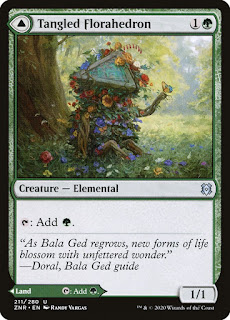
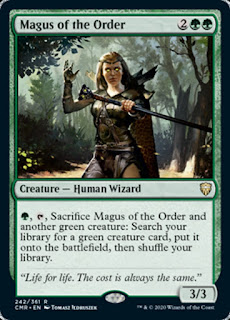
Much like with
Jwari Disruption, Tangled Florahedron isn't a bad card but it exists in this weird stasis where both sides of the card are going to be relevant at the same time. When drawn late it's a dead card no matter what you choose to do with it. That can work depending on the card but this one is mana no matter what. You are essentially choosing if you want to hit a land drop or accelerate by one at the risk of running into a removal spell. This is not an easy decision and taking that risk will depend entirely on your opponent's deck and the rest of your hand. Ultimately though, two mana ramp has been a little underwhelming if it's only making more green mana. I've been liking cards that help splash and fix in addition to the ramp more. Lastly, the biggest drawback to this is that even if you do choose the land side, you can't actually use the mana right away. That's a huge drawback to a card that wants to go in decks that need to use their mana every turn and have critical plays on turns one to three.
Magus of the Order is a one time
Natural Order that comes with a one turn delay and telegraph. I've been okay with these creature spells if they are cheap but four mana is a lot if you are giving your opponent a turn to do something about it. This is probably a good option for cubes that are a little lower level in power as a fair substitute but not for mine.
Didn't Make the Cut


Kamahl, Heart of Krosa is another
Craterhoof Behemoth variant that provides an immediate
Overrun when it's cast and then promises an extra 13 or 17 damage on its own depending on if you draw a land on your next turn. That's an awful lot of game ending potential and not being restricted to a one time effect makes this a must answer card. Both Craterhoof and
End-Raze Forerunners are really dependent on you already having a board state when you cast them, something this isn't as worried about because of how self contained it's abilities are. It can't play both offense and defense in the same way End-Raze Forerunners can due to the vigilance clause and it's lack of haste greatly reduces the amount of explosive, surprise potential the turn it's cast. The others are more likely to end a game the turn they are cast with even a modicum of board presence while this is almost guaranteed to end the game the turn after that. For eight mana, I'll take the cards that get the job done immediately. Remember that even if you can't deal lethal, you are often forcing bad blocks to the point where the next turn is trivially easy to win barring a wrath.
Court of Bounty is another in the cycle that just does absolutely nothing if you can't retain the monarch ability. Putting an extra land from your hand into play is at most going to happen once per game and that gets dramatically less likely as the game goes on. It's just not worth putting any weight behind at all. If you are able to remain the monarch, you get the option of adding a creature instead of a land. This can obviously be much better and will range from ending a game by putting
Hornet Queen into play a couple of turns early, to not actually having something at all. The variability in terms of power here is the widest of any Court and is completely dependent on your deck functioning properly and drawing the right combination of cards. That can work but it's not going to create anything on its own or pull you out of situations where you are behind and need help.
Colorless
In Out
Crystalline Crawler will be a 3/3 for 4 in most decks that aren't actively trying to abuse it. You're probably going to want to try to get it up to a 4/4 in most cases through an off color dual land or the like to feel really good about it and that shouldn't be all that difficult. That allows you to ramp the following turn up to 7 or 8 mana which is absurd. You don't even lose your creature. Even if you are only ramping up to 6 that's still a big jump considering the mana can be any color. You can just tap this for any color of mana by immediately removing the counter and in some games this is just going to act as a beater. This does quite a lot and can fit into a lot of the ramp or 5 color green decks.
I really like the design and gameplay of Crystalline Giant...when you play it online. Having to maintain and track all of these ability counters for this one card is a logistical nightmare and not worth the upkeep. It's not nearly good enough and doesn't act as a lynchpin in any particular deck. It performs fine and if I had a digital cube, I'd likely still play it but in paper there is no way.
In Out
Golos does a lot of really cool things and provides great support for the 5C green archetype that's slowly gaining traction. I've been focusing on green ramp cards that can find or create different colors of mana and this fits right in. Ramping on entry is good and that ability is extremely fun and creates stories. It's just a really cool cube card.
Precursor Golem suffers badly from being completely handled by targeted removal. Yeah, you can sacrifice your main Golem and get around that but the sacrifice decks don't really want to play this at five mana. In fact, nobody really wants to play this at five mana. That's kind of the point. It's just not nearly as good as it used to be considering the creatures you get these days.
In Out
Skyclave Relic is just a preferable option to Gilded Lotus in the 5 color Green decks as it creates multiple colors of mana instead of just strictly ramping you. Sure, it costs an extra mana but you can also use it on turn three if you don't quite have your early game ramp making it less embarrassing in your opening hand. The curve outs change a bit so you won't be jumping by three mana quite as fast but Gilded Lotus isn't really a heavily played card so no decks are going to be missing it.
Boros
In Out
Needle Spires provides some late game utility to Boros in case of board wipes as a way to continue pressuring your opponent on an empty board. Ultimately though, Boros just wants to be able to cast its spells on curve and a land that comes into play untapped and provides a choice of your two colors of mana does exactly that. In what is an ongoing theme with this cycle of lands, you won't ever have your pick of both colors of mana, you have that choice to make once and then are stuck with it. The only place this really can burn you is if you are playing a 3+ color deck or have a bunch of double color spells. I'm okay with guiding the populace towards 2 color decks (I've been doing that for a while now) and the upside of guaranteeing an untapped land is significant, particularly in Boros.
Didn't Make the Cut
If you aren't playing a Boros equipment package then Nahiri, Heir of the Ancients doesn't actually do anything. I'm not running that as a theme so this really doesn't do anything. Moving on.
Dimir
In Out
Dimir can afford a tapped land more than most but it's still a cost that you need to pay that can punish you depending on when you draw the land. The Temple cycle has only ever been just okay as Scry 1 is about as low impact as you can get. Better, more consistent mana is just going to be better.
Golgari
Didn't Make the Cut

Nissa's entire value is wrapped up in her ultimate, a stark departure from how most planeswalkers are valued. That's because her ultimate is the only ability on her worth playing. I've never been a fan of the planeswalkers that use your lands as threats unless it's late in the game and you already have too many. If you play this on curve you just can't afford to get your land blown up by a removal spell or to have it trade in combat. There are turns where it can have value, of course, but on average it never really performs all that well in the developing stages. You will probably be able to put a couple of counters on through landfall if you play her on curve, which is good because you will want to be using that ultimate because it's the most impactful part of the card. It scales well throughout the game because it hits both hand and graveyard zones which ensures one of them should have a valid target but she just doesn't do anything past that one activation. The play pattern afterwards is really boring and I don't like her nearly as much as several other Golgari planeswalkers.
Gruul
In Out
The Pain Lands are fine in the most aggressive decks because you are probably going to be the one pushing damage faster than your opponent. Gruul is much more of a midrange deck and while you really don't have to lose life that often, some draws just demand that you do if you don't have another mana source of the right color. Gruul can't afford to do that too much against some opponents and the Pathway Land just provides better mana fixing at a lower cost to your life total.
Didn't Make the Cut

Avenger of Zendikar has come in and out of my cube several times and it's a powerful late game finisher for a land based ramp deck. Where Avenger goes wide, Phylath goes tall, making one land a threat each turn. In order to maximize Avenger you really need to trigger landfall more than once, lest your plants be nothing more than insignificant pests. Phylath becomes immediately relevant with a single land drop as a 4/5 interacts very well on both sides of the battlefield. Note that you won't be getting any plants for your nonbasic lands so the better your mana fixing is, the worst this card is. Ultimately, I don't like Landfall for cube because it's just too hard to guarantee your land drops unless each activation is extremely impactful. You just don't get that many land drops this late in a game and in those scenarios where you can't trigger it you have a bunch of chump blockers and a vanilla 5/5. This can be a finisher but it requires you to draw a specific series of cards and have your opponent not play a removal spell. That's asking for a lot to go right. It didn't happen that often with Avenger of Zendikar and this doesn't do enough different that would suggest a different outcome.
Izzet
In Out
Wandering Fumarole is way too expensive and provides much too small of a benefit to Izzet decks that just don't need very much help to close out a game. You are much more likely to lose because you stumble on mana than you can't find a way to deal lethal. Like the earlier ones, Pathways come into play untapped and that's very strong.
Orzhov
In Out
Orzhov decks have enough relevant plays on turn one in both colors that I feel comfortable saying that Isolated Chapel not being able to ETB untapped on turn one does matter when it's your only source of a certain color. The Pathway land does that and I feel good about it's playability during the rest of the game as previously discussed.
Selesnya
In Out
Filter lands like Wooded Bastion function to completely fix your mana as long as you have a way to put the right color into it. If you have only white mana you can still make double green. That's very unique and it benefits decks with a lot of double pip cards. The cost is that it can't actually make colored mana on turn one or if you pay the filter cost, two things that really doesn't come up very often in two color decks. I've been happy with the filter lands on the whole but it's awkward sometimes being locked into using multiple lands within a phase. Sometimes you would rather use two mana for one thing and then hold up two mana on your opponent's turn. There are draws where that play line becomes very awkward with filter lands. The Pathway lands provide cleaner access to untapped mana.
Land
Didn't Make the Cut
Crawling Barrens required ten mana over two turns to actually attack with a vanilla 4/4. A scenario exists where you just spend entire turns putting counters on this and it eventually becomes
The Abyss as long as you don't mind spending yet another entire turn to attack for X. Yeah, this is way too slow and expensive for cube.
Conclusion
I went into Zendikar Rising thinking it didn't look very good for cube and came away wondering if I didn't add enough cards. That goes double for Commander Legends. MDFC's are literally game changing in terms of their design but present a very difficult challenge to cube curators. Many of these cards would be played if drafted because the opportunity cost is so low and they by improving the consistency of draws and decreasing mulligans, they seem to be a huge step in the right direction. The only question is, what's worth a slot? Every card you add that's generically good takes one away for something that supports an archetype or fills a role in particular decks. Add too many and you have a homogenous environment filled with generic, consistent value plays that less resemble decks and more resemble piles of cards that play well. Consistency doesn't always equal power. It's a difficult line to straddle but I like the challenge and opportunity to flex my design muscles. Strixhaven is coming up next year and they've already promised more MDFC's not only in that set but throughout the next Magic year. Decisions aren't going to be getting any easier and I'm excited to see what the future brings. Happy cubing everyone.


